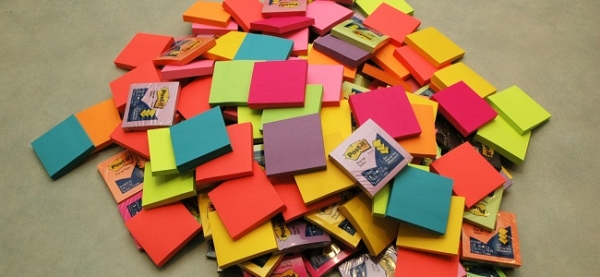Marking is a large proportion of every teacher’s time and workload, and the move towards feedback that is actionable causes new problems in getting pupils to action and respond to these targets. My first use for Post-its came from a source on Twitter (apologies for not being able to reference), which is my main source of wonderful ideas. Using sticky notes to mark in books where there are targets or actions for students to take is a simple and highly-effective strategy. I ask for them to be left in books until the next marking so that I can also see easily where I need to check improved work or mark targets. Sometimes the simplest of ideas are the most effective, and this is certainly one of them.
Although not applicable in my subject (for my sins, yes, I am a maths specialist) for on-going work, Post-its can be used to give guidance or sentence ideas, paragraph starters and other help to aid extended writing tasks. In the little bit of extended writing I do in my lessons, I find that having Post-its ready with a sentence starter to support my students who are great at maths but not as good at expressing themselves in writing, removes a barrier to them engaging in the task fully. On a similar literacy thread, I carry Post-its in my pocket for key words that students are struggling to spell, and maths has tonnes of them. It’s a discrete way of helping pupils improve the spelling, and saves you having to correct it multiple times in the same piece of work when the books need marking.
Pupils can use this resource as well as teachers, and in a variety of different ways. One that I had seen first as an NQT and not tried until recently was as peer assessment. To start with I had struggled to see how I could apply it to my subject, although I could see the use of sticking feedback onto pieces of artwork or technology work. I had failed to realise how my pupils valued feedback that wasn’t ‘permanent’, the sticky notes gave pupils the confidence to be honest because it wasn’t recorded forever into their peers’ books. I have since used sticky notes for both peer and self-assessment, sometimes just to write a note to me about what pupils are struggling on. I personally choose to take in the sticky notes (or have them stuck to the board) but I know staff who take in books with the Post-it notes in with the same end result.
My minor obsession with Post-it notes has clearly be passed onto the NQTs currently under my tutelage, and taken the use of sticky notes as starters far beyond my own practice. This year I’ve observed a couple of fantastic starters where Post-its were used to ascertain prior knowledge. One lesson this was differentiated for a low attaining Y8 class, so different questions were written on mini whiteboards on the tables and the answers from pupils were stuck onto the interactive whiteboard at the front. The teacher then used the notes on the board to start discussion around the topic for that lesson. This is a great way to check for prior understanding and misconceptions at the start of a lesson, ready to address during teaching.

I also use Post-its to spot continuing misunderstandings at the end of the lesson, through the use of exit ticket-style activities. This is probably my favourite use, and the one I use most often. I’m in complete support of strategies that need minimal planning but have maximum impact on pupils’ learning, I think any busy teacher should be. I use them in a number of different ways; the simplest is for pupils to draw (sometimes with great artistic flair) a face to represent their experience in the lesson, whether they feel that they have acquired the knowledge and understanding set out in the learning objectives. With all my exit tickets I vary between asking for names and keeping them anonymous. There are appropriate times for both, although I definitely see a difference in reflection when it is anonymous; it seems to remove the fear factor of getting it wrong, which we certainly struggle with as maths teachers specifically. This comes in handy when I choose to use exit tickets with questions; these tend to be differentiated (I use gold, silver and bronze) so pupils choose the question and answer it on the sticky note. Pupils then stick their answers on the wall by the door on their way out; I normally tell pupils either dartboard or snooker table, as per the display in the picture. After the lesson I sort them into the different questions, then look for correct answers and any issues that arise. If there is one strategy that you take from this article this is the one with the biggest impact in my lesson.

Taking off my maths-teacher hat, I used sticky notes when teaching ICT in a way that can apply to a whole host of different subjects. Progression through assessed content needs tracking pupil-by-pupil. I’ve seen it done incredibly well by subjects who have Post-its for each pupil, to either move through the units completed, or add a sticky note with their name when that unit is completed. It’s a good way of tracking where pupils are, and also what needs marking! To incorporate all subjects, this concept can be extended to the variety of different forms of confidence tracking. I’ve heard of confidence mountains (climbing to the top), thermometers, scales, the list goes on. I’m perhaps not the best advocate for these, as I like to test ‘confidence’ to see whether it is founded or not, but it is a one way to direct differentiated questioning.
There are numerous other ways that sticky notes can be used in a classroom that I can’t go into detail about here; I use them to have pupils write their summaries in the form of tweets, and stick them to the wall where the Twitter feed is. I’ve seen teachers write differentiated starters in the form of questions stuck on pupils’ books, use for discrete praise, ask questions of the teacher, use Post-its to brainstorm ideas then organise them, I used them to plan this article! The scope is endless, if you have enough imagination.
There is no part of a lesson that wouldn’t benefit from having some sticky notes to hand, and I would advocate them being in every teacher’s toolkit with board pens etc. My pupils like the novelty of not writing in their books, and love sticking them above where I can reach! They provide teachers and pupils with the power to be reflective, to be organised, to ask questions of their learning and understanding. They provide the opportunity to be a little creative, the freedom to have a set of strategies that don’t take ages to plan or resource, and they can be very inexpensive (careful of buying tiny ones though, I made that error when I got excited by the price). I am continuing to learn how to use this powerful resource, and please get in touch on Twitter if you have any brilliant ideas. Share ideas with those you work with and beyond.
Do you use sticky notes in your teaching work? Let us know in the comments.


















